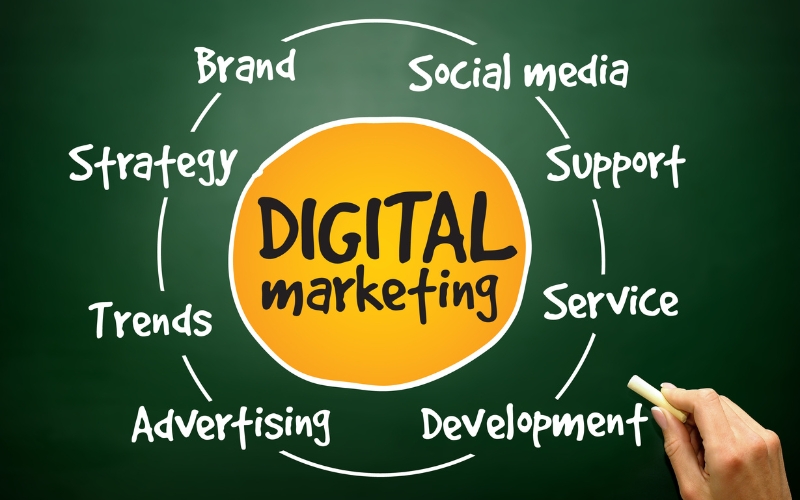In today’s competitive digital landscape, businesses invest significant resources into marketing campaigns to achieve growth and reach their target audiences. However, without a clear understanding of the impact these efforts have on the bottom line, it’s impossible to determine their effectiveness. This is where measuring ROI in digital marketing becomes crucial. ROI helps businesses evaluate whether their marketing strategies are generating sufficient returns relative to the costs involved. In this guide, we’ll explore the fundamentals of ROI in digital marketing, key metrics to track, and the essential tools and techniques that can help you measure and optimize your marketing performance.
Understanding ROI in Digital Marketing

In ROI in Digital Marketing, Return on Investment (ROI) is a critical metric used to evaluate the effectiveness of campaigns and strategies. It provides insights into whether your marketing efforts are yielding profitable results relative to the costs incurred. Understanding and measuring ROI in Digital Marketing ensures that businesses can make informed decisions to optimize their marketing budgets and achieve desired outcomes.
What is ROI and Why is it Important?
ROI in Digital Marketing, or Return on Investment, measures the financial return generated by a specific marketing campaign compared to the cost of running that campaign. It essentially answers the question: “Am I getting value for the money I’m spending on my digital marketing efforts?” By calculating ROI in Digital Marketing, businesses can determine which channels and strategies are most effective and where improvements are needed.
In the dynamic world of digital marketing, where businesses invest heavily in paid advertisements, content creation, and search engine optimization, ROI in Digital Marketing serves as a compass. It helps businesses:
- Identify high-performing marketing channels.
- Allocate budgets to strategies that yield the best returns.
- Justify marketing spends to stakeholders.
- Detect underperforming campaigns to tweak or discontinue them.
Without tracking ROI in Digital Marketing, businesses risk wasting valuable resources on campaigns that may not contribute to their growth objectives.
The ROI Formula Explained
The formula for calculating ROI in Digital Marketing is straightforward and can be applied universally across different marketing activities:
ROI = [(Net Profit from Campaign − Campaign Cost) / Campaign Cost] * 100
Let’s break this down:
- Net Profit from Campaign: The total revenue generated directly from the campaign.
- Campaign Cost: The total expenditure on the campaign, including ad spend, tools, resources, and personnel costs.
For example, if a Google Ads campaign costs $2,000 and generates $5,000 in revenue, the ROI in Digital Marketing can be calculated as:
ROI = [(5000 − 2000) / 2000] × 100 = 150%
A 150% ROI in Digital Marketing means that for every dollar spent, the campaign earned $1.50 in profit. Positive ROI indicates a profitable campaign, while a negative ROI highlights the need for reassessment.
Why Businesses Must Measure ROI
- Optimize Marketing Budgets: By measuring ROI in digital marketing, businesses can allocate resources more efficiently, focusing on campaigns and channels that deliver the highest returns. For instance, if email marketing generates a higher ROI in digital marketing than social media ads, a business might choose to increase its email marketing budget.
- Enhance Decision-Making: ROI in digital marketing provides a data-driven basis for making strategic decisions. It empowers marketers to refine targeting, messaging, and channel selection to improve performance.
- Improve Campaign Performance: Monitoring ROI in digital marketing encourages continuous improvement. Marketers can experiment with different strategies, test creative elements, and identify what resonates best with their audience.
- Stakeholder Confidence: Demonstrating clear ROI in digital marketing builds trust with stakeholders by showing that marketing efforts contribute to the company’s bottom line.
- Stay Competitive: In a competitive market, measuring ROI in digital marketing ensures that businesses stay ahead by leveraging strategies that maximize profitability.
Understanding ROI in digital marketing is essential for long-term success. It allows businesses to evaluate the effectiveness of their campaigns, optimize their strategies, and ensure that every dollar spent contributes to their growth objectives. With a clear focus on ROI, marketers can drive meaningful results and achieve sustainable business growth.
Key Metrics to Track for Accurate ROI Measurement

Accurately measuring ROI in digital marketing requires tracking specific metrics that provide insight into campaign performance and the overall effectiveness of your strategies. These metrics fall into three main categories: traffic, conversion, and customer metrics. Together, they create a comprehensive picture of how well your marketing efforts are achieving their goals.
Traffic Metrics: Analyzing Visitor Behavior
Traffic metrics are the foundation for understanding how users interact with your digital presence. They highlight the volume and quality of visitors driven to your website or landing pages through various marketing efforts. Key traffic metrics include:
- Website Visits
This metric shows the total number of visitors to your website over a given period. A high number of visits indicates that your campaigns are successfully driving traffic. However, it’s essential to pair this metric with engagement and conversion metrics to gauge the quality of the traffic.
- Session Duration
Session duration measures the amount of time visitors spend on your site. Longer session durations often indicate that users find your content valuable and engaging, which can lead to better conversion rates.
- Bounce Rate
Bounce rate represents the percentage of visitors who leave your website after viewing only one page. A high bounce rate suggests issues with user experience, page relevance, or the effectiveness of your marketing message. Reducing bounce rates can significantly improve ROI.
Conversion Metrics: Measuring Campaign Effectiveness
Conversion metrics focus on actions that align with your business objectives, such as generating leads or sales. They are direct indicators of how effectively your campaigns are driving desired outcomes. Key conversion metrics include:
- Click-Through Rate (CTR)
CTR measures the percentage of users who click on your ad or call-to-action (CTA) after seeing it. A high CTR indicates that your ad or content is compelling and resonates with your target audience.Formula:CTR=( Clicks / Impressions )×100
- Lead Generation
This metric tracks the number of potential customers who provide their information, such as email addresses or phone numbers, in exchange for valuable content or offers. Effective lead generation campaigns typically have a clear and enticing CTA.
- Sales Figures
Sales data directly reflects the revenue generated from your marketing efforts. Tracking sales conversions helps determine the financial impact of your campaigns, allowing for precise ROI calculations.
Customer Metrics: Evaluating Value and Costs
Customer metrics assess the profitability of acquired customers and the costs associated with gaining them. These metrics provide deeper insights into the long-term success of your marketing strategies. Key customer metrics include:
- Customer Lifetime Value (CLV)
CLV represents the total revenue a business can expect from a single customer over their lifetime. Understanding CLV helps allocate marketing budgets to campaigns that attract high-value customers. Formula:CLV=Average Purchase Value × Purchase Frequency × Customer Lifespan
- Cost Per Acquisition (CPA)
CPA calculates the cost of acquiring one customer. A lower CPA indicates that your campaigns are efficient in converting leads into paying customers.Formula:CPA=Total Campaign Cost / Total Conversions
- Return on Ad Spend (ROAS)
ROAS measures the revenue generated for every dollar spent on advertising. It’s a crucial metric for evaluating the effectiveness of paid campaigns.Formula:ROAS=Revenue / Ad Spend.
Tools and Techniques for ROI Measurement in Digital Marketing

Measuring ROI in digital marketing requires the right combination of tools and techniques to ensure accurate data collection, analysis, and actionable insights. With numerous platforms and methods available, businesses can track and optimize their marketing efforts effectively. This section focuses on three key aspects: tools for ROI measurement, the role of UTM parameters, and the importance of A/B testing and real-time performance monitoring.
Essential Tools for ROI Measurement
The right tools are indispensable for gathering and analyzing data. Below are some of the most widely used and effective tools for measuring ROI in digital marketing:
- Google Analytics
Google Analytics is a free yet powerful platform that provides detailed insights into website traffic, user behavior, and campaign performance. It helps businesses understand where their traffic is coming from, how users interact with their content, and what actions they take on the site. Key features include tracking conversions, setting up goals, and attributing revenue to specific campaigns.
- HubSpot
HubSpot is an all-in-one marketing, sales, and CRM platform that tracks ROI by integrating various aspects of digital marketing. From email marketing to social media campaigns, HubSpot allows users to see the performance of each channel and calculate the revenue generated by each campaign. Its robust reporting tools also provide insights into customer acquisition costs (CAC) and customer lifetime value (CLV).
- SEMrush
SEMrush is a versatile digital marketing tool that specializes in SEO and PPC campaign tracking. It provides data on keyword performance, competitor analysis, and website rankings. Additionally, SEMrush includes a “Traffic Analytics” feature, which can help businesses identify high-performing channels that contribute to ROI.
- UTM.io
For managing UTM parameters efficiently, UTM.io simplifies the creation, management, and organization of tracking URLs. This tool ensures accurate campaign tracking and attribution.
- Kissmetrics
Focused on customer behavior, Kissmetrics offers insights into user journeys and conversion paths. It highlights the steps users take before making a purchase, enabling businesses to identify and improve high-converting touchpoints.
The Role of UTM Parameters in ROI Measurement
UTM parameters are tags added to URLs to track the performance of specific campaigns. These parameters provide detailed insights into how users find and interact with your content. Common UTM parameters include:
- Source: Identifies where the traffic is coming from (e.g., Google, Facebook).
- Medium: Specifies the marketing medium (e.g., email, CPC, social).
- Campaign: Tracks the name of the specific campaign (e.g., SummerSale2024).
By implementing UTM parameters in your URLs, you can measure which campaigns, platforms, and strategies are driving the most traffic and conversions. Tools like Google Analytics automatically interpret UTM data, making it easier to attribute ROI to specific campaigns.
A/B Testing and Real-Time Performance Monitoring
A/B Testing
A/B testing involves comparing two versions of a marketing asset (e.g., an ad, email, or landing page) to determine which one performs better. For example, you can test different headlines, CTAs, or visual elements. The results provide actionable insights into what resonates most with your audience, allowing you to optimize campaigns for better ROI.
Real-Time Performance Monitoring
Tracking campaign performance in real time allows businesses to make swift adjustments to maximize outcomes. For instance, if an ad campaign is underperforming, real-time data enables marketers to tweak targeting, budgeting, or creative elements to improve results. Platforms like Google Ads and Facebook Ads Manager provide real-time dashboards for monitoring key metrics such as impressions, clicks, and conversions.
Conclusion
Measuring ROI in digital marketing is more than just a metric—it’s a critical component of strategic decision-making. By understanding the concept of ROI, tracking the right metrics such as traffic, conversions, and customer value, and leveraging tools like Google Analytics and SEMrush, businesses can gain actionable insights to improve their campaigns. Techniques like A/B testing and real-time monitoring further enhance the precision of ROI calculations. Ultimately, by focusing on ROI, marketers can allocate resources effectively, enhance their strategies, and drive sustainable growth in today’s competitive digital ecosystem.




